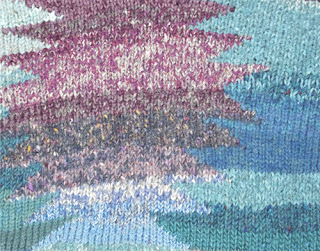 |
| Plotulopi |
A few years ago I visited Iceland. It was wonderful, a gorgeous country with lovely people and fantastic wool. The Icelandic sheep is an ancient breed which the Viking settlers brought with them. The wool has two layers to it. The outer layer (tog) is made up of long fibres, which are strong and water repellent. The inner layer (thel) is quite different, it’s very light and the fibres are shorter so it traps a lot of air and is a good insulator. Lopi yarns are produced from a mix of both fibres.
My first project was a cardigan for my granddaughter knitted in Plotulopi. This comes as a plate and is hardly spun at all! It needs very light handling or it breaks. But it’s so light that it’s really easy to splice it back together by dampening the two ends and rolling them in your palms. You can also double it up by knitting simultaneously with wool from the outside and the centre of the disc. This twists the fibres and makes it stronger. However a transformation occurs when you gently wash the finished garment. The fibres mesh together and become fluffy. It makes a very light and warm fabric
Since then I’ve knitted these in Lett-lopi, which is almost a DK weight, on a 4mm circular pin. They are all seamlessly constructed. The yoked jacket had a steek in the middle of the front. Yes it was a bit scary!

To prevent the cut edges from stretching out of shape I stitched fabric to the back and cut through both layers. The front bands were knitted separately and stitched on by hand. The closures are vintage hooks and eyes.

The little seed stich adds an extra layer. It needs to be loosely stranded at the back.

This navy sweater was inspired by traditional Norwegian knits. It only had steeks at the armholes which were much more manageable.
I brought some Plotulopi yarn home with me from Iceland and then discovered that I can get it here in the UK from Carreg Yarns in Wales, www.carregyarns.com. They have the complete range of these lovely wools in all the weights and colours. It’s worth getting some shade cards to drool over and ponder as you dream up the next gorgeous garment!


















